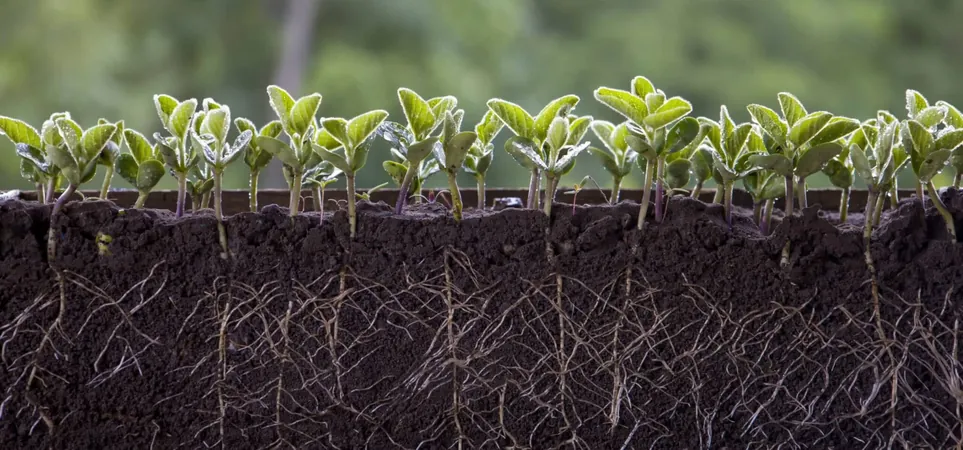
Unlocking the Secrets: How 'Smart' Roots Strategically Conserve Water!
2025-03-28
Author: John Tan
In a groundbreaking study released today, researchers have revealed astonishing insights into how plants manage their water use with remarkable precision. This research demonstrates that plants can adapt their root hydraulics to optimize water usage depending on soil moisture levels.
When the topsoil dries out, plants have the ability to shift their water uptake deeper into the ground, while at the same time significantly reducing their consumption of moisture from the topsoil. Conversely, when the topsoil is replenished by rainfall, these smart organisms rapidly recalibrate their water absorption strategies to prioritize surface water, conserving energy by tapping into the moisture readily available above.
The study specifically examined wheat and permanent grass fields, uncovering that deep-root water uptake is directly influenced by the moisture level of the topsoil. This finding is revolutionary, suggesting that topsoil not only acts as a resource but also acts as a crucial indicator that coordinates how plants use water at various soil depths.
Dr. Xiaoxian X Zhang, the lead author of the study, expressed that these insights could transform our understanding of how plants cope with water shortages and help streamline efforts in developing drought-resistant plant varieties. 'We believe this is the first time this complex interaction has been observed in real-world conditions,' Dr. Zhang stated.
Unlike controlled pot-based experiments, field conditions present unique challenges for plant adaptation to water stress, which have remained largely underexplored. The research reveals that as topsoil moisture dissipates, plants ingeniously increase their water extraction from deeper soil layers. When rains soak the topsoil, they swiftly reverse this strategy, drawing less from below and more from the surface—highlighting an extraordinary adaptability that could revolutionize agricultural practices.
This phenomenon is referred to in scientific circles as 'root economy.' Despite the tendency of topsoil water to evaporate, it is rich in essential nutrients, making it a prime target for absorption when available. Therefore, plants judiciously reserve deeper subsoil water as a backup, showcasing a sophisticated balance in resource management.
The precise mechanisms behind these adaptive behaviors remain a mystery. Preliminary findings indicate that plants might alter their root hydraulic permeability at varying depths through the action of aquaporins—specialized proteins that regulate water flow between cells. However, what triggers this remarkable regulation is still unknown.
This extensive research involved analyzing root water uptake, water potential, and permeability in both a wheat field and a permanent grass field over a three-month period. Notably, the grass demonstrated a higher resilience to topsoil water stress and efficiency in utilizing moisture from deeper soil layers compared to wheat.
These findings not only enhance our understanding of the intricate ways in which plants navigate sporadic water challenges but also underscore the importance of exploring adaptive changes in root water conductivity, root structure, and the surrounding soil environment. This knowledge is key to developing and selecting drought-resistant crops that can thrive in increasingly water-scarce conditions, a critical step amid the challenges posed by climate change.
Stay tuned as researchers continue to decode the sophisticated behaviors of plant roots and their potential to revolutionize sustainable agriculture!





 Brasil (PT)
Brasil (PT)
 Canada (EN)
Canada (EN)
 Chile (ES)
Chile (ES)
 Česko (CS)
Česko (CS)
 대한민국 (KO)
대한민국 (KO)
 España (ES)
España (ES)
 France (FR)
France (FR)
 Hong Kong (EN)
Hong Kong (EN)
 Italia (IT)
Italia (IT)
 日本 (JA)
日本 (JA)
 Magyarország (HU)
Magyarország (HU)
 Norge (NO)
Norge (NO)
 Polska (PL)
Polska (PL)
 Schweiz (DE)
Schweiz (DE)
 Singapore (EN)
Singapore (EN)
 Sverige (SV)
Sverige (SV)
 Suomi (FI)
Suomi (FI)
 Türkiye (TR)
Türkiye (TR)
 الإمارات العربية المتحدة (AR)
الإمارات العربية المتحدة (AR)